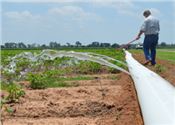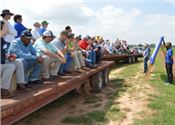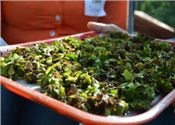|
Red River Station Field Day Focuses On Water Use
BOSSIER CITY, LA.
The LSU AgCenter Red River Research Station just south of Bossier City is known for and is still a leader in greenhouse tomato studies. But the new focus is water resources.
Located only a few miles from the Red River, a major waterway leading to the Mississippi, the 572-acre station has always had an interest in water “as far back as retired U.S. Senator J. Bennett Johnston of Shreveport,” said Rogers Leonard, LSU AgCenter associate vice president. “Senator Johnston helped secure funding for research on the Red River because he knew how important it was to this area.”
The first field day with a major emphasis on water resources was held at the station on June 15.
“The field day focused on improved water use in agricultural operations – specifically, efficient irrigation practices and reducing the impact of agricultural irrigation on nonpoint-source water pollution,” said Pat Colyer, AgCenter Northwest Region director. “Because of the increased demands for water globally, a comprehensive approach will be needed to address the increasing demands on water use in agriculture.”
One area of study centers on the invasive aquatic fern giant salvinia, which grows in many Louisiana waterways. Steve Micinski, AgCenter entomologist, said the root system of the salvinia can reach 3 feet in length. Besides presenting a navigation problem, the free-floating weed depletes the oxygen in the water.
“We are using weevils to battle salvinia, and they work well. But they die off each winter in north Louisiana,” said Micinski. “AgCenter entomologists are searching the fern’s native range in South America in hopes of finding the weevil in areas where the climate is more similar to north Louisiana. If a more cold-tolerant weevil can be located, we eventually hope to release it in north Louisiana.”
Changyoon Jeong, AgCenter water quality specialist, reported on his latest study looking at controlling nutrient losses such as nitrogen and phosphorus in row crop fields.
“It is important for agriculture to have nutrient efficiency and protect our watersheds,” he said. “One of the strategies to prevent water contamination is use of biochar, which is produced through incomplete burning in the partial or total absence of oxygen. It enhances nutrient retention.” This study is being done in a cotton field where poultry litter was applied, he said.
Jeong is also working with researcher Jong Ham, AgCenter plant pathologist, to examine disease management in soybeans through various soil amendments and foliar treatments.
“The addition of biochar and poultry manure to the soil is the major approach for the soil treatments and amendments,” Ham said. “The spraying of antagonistic bacteria is for the foliar treatments.”
Stacia Davis, AgCenter irrigation engineer, reported on a project comparing different types of soil moisture sensors. “If the plant isn’t getting enough water, it’s expending more energy trying to get the water than it is growing,” said Davis. The soil water potential and volumetric sensors performed differently in northwest Louisiana compared to northeast Louisiana, she said.
Naveen Adusumilli, AgCenter economist, said the water quality team at the station is developing an irrigation app.
“It would provide dollar amounts on what it would cost and the net returns when making irrigation efficiency improvements on a farm,” Adusumilli said. Examples of improvements include using surge valves, flow meters, moisture sensors, fuel engine changes, and a combination of the above.
Syam Dodla, AgCenter soil and fertility specialist, talked about his study comparing furrow irrigation (all rows) and skip-row irrigation (alternate rows).
“Because agriculture is a major consumer of freshwater and the long-term prospect is for a shortage of freshwater, there is an urgent need to develop new conservation strategies,” Dodla said.
Dodla said that one might expect skip row irrigation to save 50 percent of water usage, but it doesn’t.
“The overall benefit of skip row varies, depending on soil type. Though it is well known that the heavy soils have better lateral seepage than light-textured soils, there are still many questions to be answered to better understand the feasibility of skipping a row.”
Blair Buckley, AgCenter agronomist, talked about his studies on drought and flood tolerance traits of soybean varieties.
“We’re looking at some drought-tolerant beans that have a slow wilting trait, and most of the flood-tolerant beans have been wild soybeans,” Buckley said.
Dan Fromme, AgCenter corn, cotton and grain sorghum specialist, said nitrogen management in corn is a challenge because of the rainfall we get in Louisiana. “Don’t put all your eggs in poultry litter as your nitrogen source because some commercial application will be needed.” ∆

Bill Waltman, research associate, starts a skip row irrigation system on a plot of
soybeans at the LSU AgCenter Red River Research Station field day on June 15.
Photos by Tammi Arender

Blair Buckley, second from right, agronomist, reported on his research looking into
drought or flood resistant traits in soybeans at the Red River Research Station
field day on June 15.

Naveen Adusumilli, agricultural economist, at right, shares information about a new app
for smart phones that he’s helping to develop that will help farmers know when to irrigate their crops.

This is a tray of giant salvinia, which is an aquatic fern that causes
navigation problems on Louisiana waterways as well as depletes the water of oxygen.
|
|